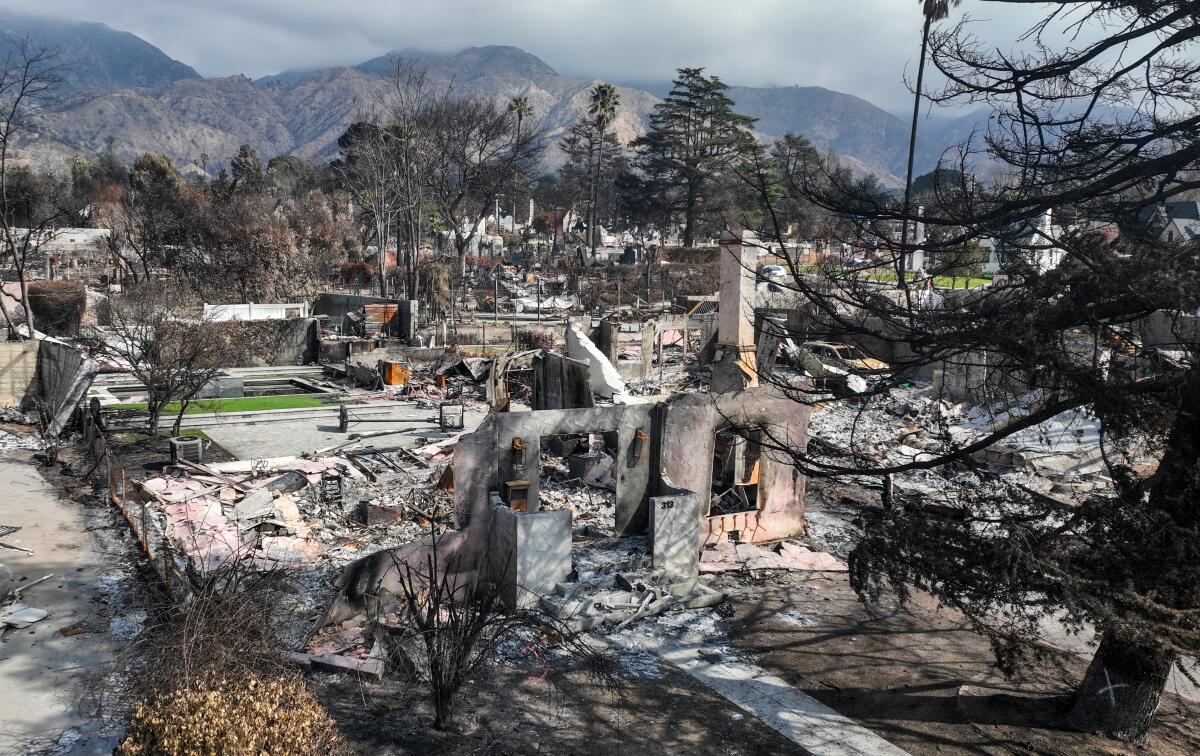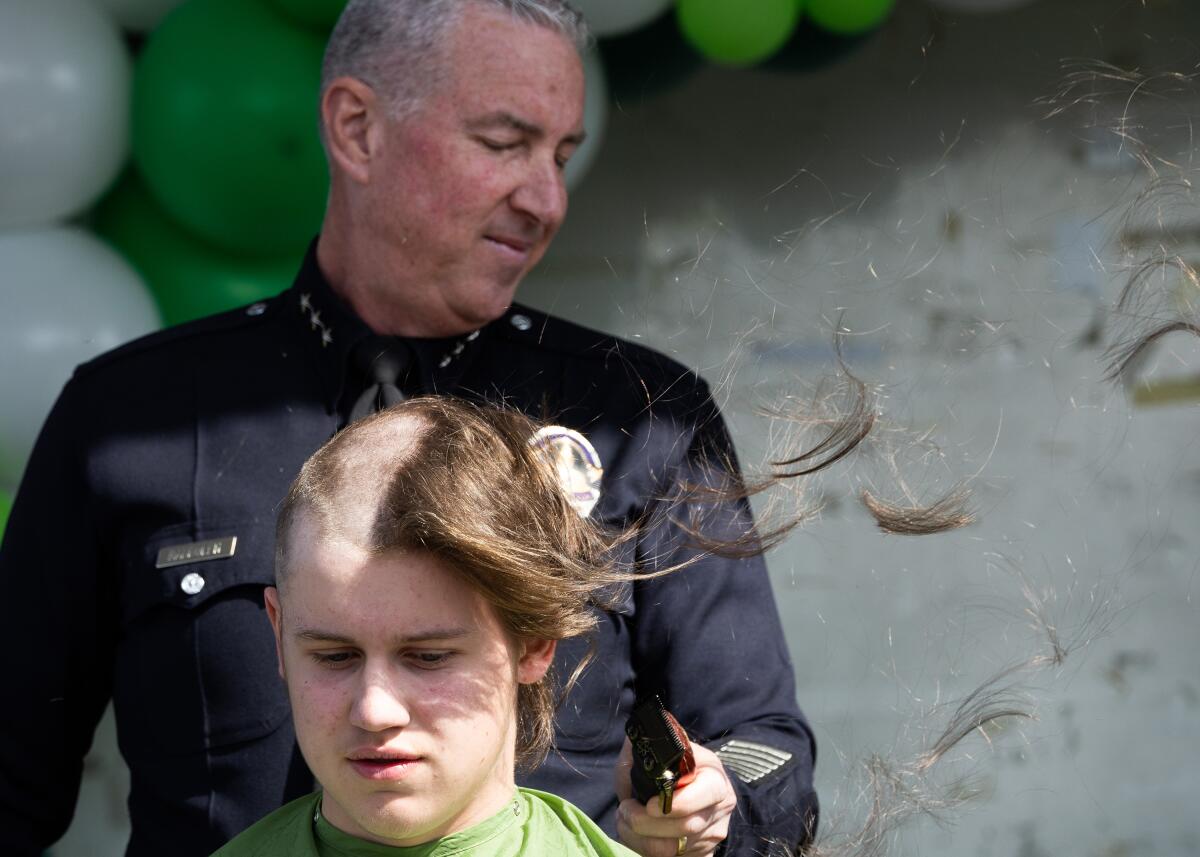How is LAUSD’s cellphone ban going? Depends on whom you ask

- Share via
Good morning. Here’s what you need to know to start your Monday.
- An early check-in on the LAUSD’s cellphone ban.
- Edison customers are paying more for fire prevention. So why are there more fires?
- The California-Mexico border, once overwhelmed, is now nearly empty.
- And here’s today’s e-newspaper.
Some students note positive changes thanks to LAUSD’s cellphone ban. Others are finding ways around it.
If you’re 35 or older (like me), think back to your time in middle and high school.
The art of getting distracted in class was almost entirely analog — writing and passing notes, doodling in notebooks or textbooks, whispering or signaling to friends, throwing pencils up into those porous ceiling tiles.
When I graduated high school, texting was still in its infancy and smartphones had not yet proliferated to become the cultural necessity they are today. It feels quaint by this decade’s standards, as most teens have never known a time without having a pocket-sized entertainment system that facilitates many aspects of their daily lives.
So when I was reading Times enterprise reporter Daniel Miller’s story about the recent ban on cellphones for students in the nation’s second-largest school district, my overwhelming thought was: “Thank goodness iPhones didn’t exist when I was 17.”
The Los Angeles Unified School District cellphone ban took effect in mid-February, affecting roughly 800 campuses. At many schools, scholars are required to put their phones in magnetically sealed pouches made by Yondr, a local company that gained popularity through its use at film premieres and live entertainment events.

Teachers, district leaders and some students say they’re already seeing a difference, Daniel reported last week.
One school staff member told him it was the best thing to happen to education “since the invention of cellphones.”
“Amid the roll-out, [teachers and administrators] have cited anecdotal evidence and data that show the negative health effects of unfettered access to smartphones, which have contributed to an increase in anxiety, depression and other issues for students, especially since the COVID-19 pandemic,” Daniel wrote.
LAUSD school board member Nick Melvoin, who introduced the resolution to ban cellphones, said school psychologists were reporting fewer fights and drug issues since the ban took place. Some students said they were more engaged in class without their devices.
“Sometimes the lectures can be a little boring, and you have that urge to scroll on TikTok or Instagram, but that’s not the best habit,” Angie Mendoza, a senior at University High School Charter in Los Angeles’ Sawtelle neighborhood, told Melvoin during a recent visit. “I’ve been getting better grades because I’ve been paying more attention in class.”
Other students are less thrilled and are finding ways around the ban. Some described the “dark arts of circumvention” to Daniel.

“As of today, I don’t know anybody who has put their phones into a pouch,” Madison Thacker, a senior at Van Nuys High School’s Performing Arts Magnet, told him. “Kids are putting in old phones, they are putting in burner phones, they are putting in battery packs. And most popular: calculators.”
Aside from decoys, some students have figured out how to break into sealed pouches using other magnets, pencils or old-fashioned elbow grease.
A majority of U.S. teachers agree that cellphone-based distractions pose a major problem in classrooms, according to Pew Research Center.
Although many in the education field support cellphone restrictions, some argue that blanket bans are too carceral and obscure deeper problems, including addictive social media platforms and ineffective teaching practices.
Research into the effects that banning cellphones has on young people is mixed and limited.
One United Kingdom study published last month found “no evidence that restrictive school policies are associated with overall phone and social media use or better mental wellbeing in adolescents.”
For more, read Daniel’s full story on how LAUSD’s cellphone ban is going and what’s next for the district.
Today’s top stories

Edison customers are paying more for fire prevention. So why are there more fires?
- “There were 178 fires sparked by Edison equipment last year, up from 107 in 2015,” Melody Petersen reports. That’s despite the billions of dollars the company has spent to prevent them, including $1.9 billion last year.
- Some officials say much of the blame falls on a 2019 state law signed by Gov. Gavin Newsom that limited the financial liability of utilities for wildfires they caused.
Southern California healthcare agencies fear cuts to HIV prevention will cost lives.
- Reports that Trump administration officials are considering cuts to key programs for the prevention of HIV and AIDS have sparked outrage among major regional LGBTQ+ service organizations.
- “It’s a 180-degree turn, to threaten to take this away,” one healthcare expert told Times reporter James Rainey. “It feels personal and it makes zero sense.”
Once overwhelmed, the California-Mexico border is now nearly empty.
- “Shelters that once received migrants have closed, makeshift camps where migrants waited for processing are barren, and nonprofits have begun shifting their services to established immigrants in the U.S. who are facing deportation, or migrants stuck in southern Mexico,” writes The Times’ Andrea Castillo.
- The stark change comes after the Border Patrol was bolstered by 750 U.S. military troops dispatched to the San Diego area.
What else is going on
- The body of missing LAFD firefighter Connor J. Lees has been found.
- The first layers of soil will be laid on the 101 Freeway wildlife crossing, the world’s largest.
- The White House ordered the firing of a federal prosecutor in L.A. who was prosecuting a case against a former Fatburger chief executive, sources say.
- An L.A. County Sheriff’s Department deputy shot a man Saturday evening in West Hollywood.
- Comedian Paul Rodriguez was arrested on suspicion of narcotics possession in Burbank.
- A California national park site near San Francisco was vandalized with hazardous chemicals and hate speech.
- Did you buy a lottery ticket in Anaheim? You may now be a multimillionaire.
Get unlimited access to the Los Angeles Times. Subscribe here.
Commentary and opinions
- The Reagan administration took security seriously, unlike Trump, writes columnist George Skelton.
- Pete Hegseth says he knew what he was doing. In that case, Times columnist Robin Abcarian argues, he should resign.
- America has gotten ruder. And it’s starts at the very top, writes columnist Mark Z. Barabak.
- The Dodgers visiting Trump’s White House goes against everything they supposedly represent, Times sports columnist Dylan Hernández writes.
- To understand homelessness, listen to homeless people. Here’s what The Times’ Carla Hall learned.
This morning’s must reads

Gregory Nava unpacks how his 1997 film, “Selena,” has stood the test of time. Not long after the Queen of Tejano Music was murdered, her relatives tapped the director to helm a film about her life. “Selena’s family felt very strongly that only a Latino filmmaker would be able to understand the culture, her ethos and the world she came from,” Nava told De Los’ Andrea Flores.
How can we make this newsletter more useful? Send comments to essentialcalifornia@latimes.com.
For your downtime

Going out
- 🍇 Eight white (and pink) wines to go with Angelenos’ rites of spring.
- 🍸✈️ We have some tips to help you get inside LAX’s luxury lounges.
Staying in
- ‘The White Lotus’ Season 3, Episode 7 recap: Rick has his showdown.
- 🍖 Here’s a recipe for poc chuc (orange-and-lime-marinated grilled pork).
- ✏️ Get our free daily crossword puzzle, sudoku, word search and arcade games.
And finally ... your photo of the day
Show us your favorite place in California! Send us photos you have taken of spots in California that are special — natural or human-made — and tell us why they’re important to you.

Today’s great photo is from Times staff photographer Myung J. Chun. Members of the Los Angeles police and fire departments took part in the 22nd annual St. Baldrick’s fundraiser, with members and others in the community having their heads shaved in solidarity with child cancer patients.
Have a great day, from the Essential California team
Ryan Fonseca, reporter
Amy Hubbard, deputy editor, Fast Break
Karim Doumar, head of newsletters
Check our top stories, topics and the latest articles on latimes.com.




